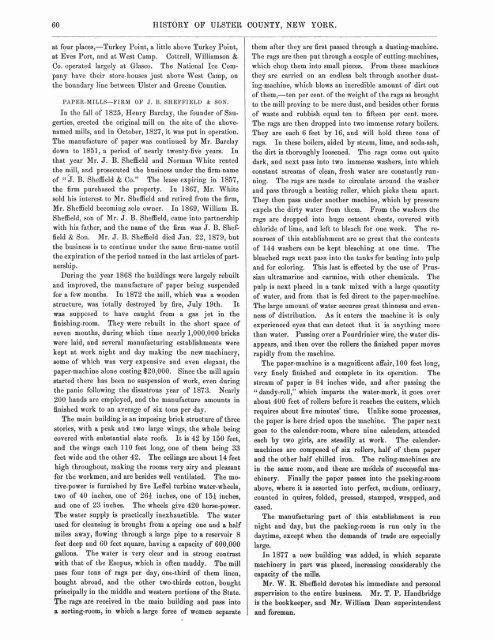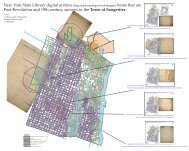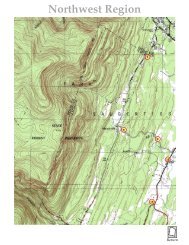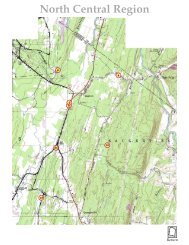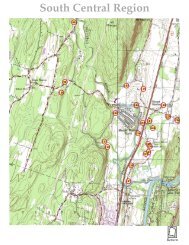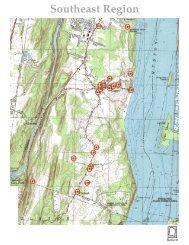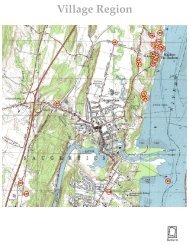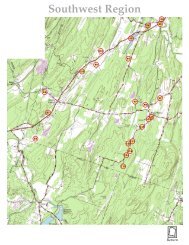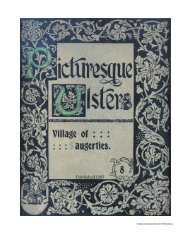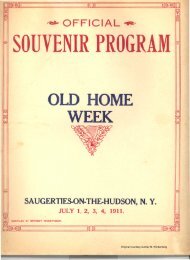1880 History of Ulster County New York - Saugerties Section
The 1880 History of Ulster County compiled by Nathaniel Bartlet Sylvester was one of a number of advanced subscription vanity publications centered on county-based histories produced by Sylvester. The information basically duplicates the gazettes, commercial white papers and census records of the day and utilized the writing skills of reporters in the local press who gathered their research directly from the wealthy businessmen that paid the subscription. Saugerties had a wealth of information already collected from The Pearl published five years earlier and has the most pages of any town in this volume. This history is the predecessor to later studies by Benjamin Myer Brink and Alfonso Clearwater as well as Marius Schoonmaker after the turn of the century. When all of these are taken together and discounted for the lack of accurate translation of the earliest Dutch and German documents the result is a history of the Kingston territory of the mid Hudson valley generally referred to as the Kingston Commons. Interest in this larger history is the natural outcome of a reading of this history of Saugerties.
The 1880 History of Ulster County compiled by Nathaniel Bartlet Sylvester was one of a number of advanced subscription vanity publications centered on county-based histories produced by Sylvester. The information basically duplicates the gazettes, commercial white papers and census records of the day and utilized the writing skills of reporters in the local press who gathered their research directly from the wealthy businessmen that paid the subscription. Saugerties had a wealth of information already collected from The Pearl published five years earlier and has the most pages of any town in this volume.
This history is the predecessor to later studies by Benjamin Myer Brink and Alfonso Clearwater as well as Marius Schoonmaker after the turn of the century. When all of these are taken together and discounted for the lack of accurate translation of the earliest Dutch and German documents the result is a history of the Kingston territory of the mid Hudson valley generally referred to as the Kingston Commons.
Interest in this larger history is the natural outcome of a reading of this history of Saugerties.
You also want an ePaper? Increase the reach of your titles
YUMPU automatically turns print PDFs into web optimized ePapers that Google loves.
HISTORY OF ULSTER COUNTY, NEW YORK.<br />
at four places,-Turkey Point, a little above Turkey Point,<br />
at Eves Port, and at West Camp. Cottrell, Williamson &<br />
Co. operated largely at Glasco, The National Ice Company<br />
have their store-houses just above West Camp, on<br />
the boundary line between <strong>Ulster</strong> and Greene Counties.<br />
PAPER-MILLS-FIRM OF J. B. SHEFFIELD di SON.<br />
In the Fall <strong>of</strong> 1825, Henry Barclay, the founder <strong>of</strong> <strong>Saugerties</strong>,<br />
erected the original mill on the site <strong>of</strong> the abovenamed<br />
mills, and in October, 1827, it was put in operation.<br />
The manufacture <strong>of</strong> paper was continued by Mr. Barclay<br />
down to 1851, a period <strong>of</strong> nearly twenty-five yeam. In<br />
that year Mr. J. B. Sheffield and Norman mrliite rented<br />
the mill, and prosecuted the business under the firm-name<br />
<strong>of</strong> " J. B. Sheffield & Co." The lease expiring in 1857,<br />
the firm purchased the property. In 1867, Mr. White<br />
sold his interest to Mr. Sheffield and retired from the firm,<br />
Mr. Sheffield becoming sole owner. In 1869, Williani R.<br />
Sheffield, son <strong>of</strong> Mr. J. B. Sheffield, came into partnership<br />
with his father, and the name <strong>of</strong> the firm was J. B. Shcffield<br />
& Son. Mr. J. B. Shefield died Jan. 22, 1879, but<br />
the business is to continue under the same firm-name until<br />
the expiration <strong>of</strong> the period named in the last articles <strong>of</strong> partnership.<br />
During the year 1868 the buildings were largely rebuilt<br />
and improved, the manufacture <strong>of</strong> paper being suspended<br />
for a few months- In 1872 the mill, which was a wooden<br />
structure, was totally destroyed by fire, July 19th. It<br />
was supposed to have caugllt from a gas jet in the<br />
finishing-room. They were rebuilt in the short space <strong>of</strong><br />
seven months, during which time nearly 1,00O10(J0 bricks<br />
were laid, and several manufacturing establishment~ were<br />
kept at work night and day making the new machinery,<br />
some <strong>of</strong> which was very expensive and even elegant, the<br />
paper-machine alone costing $20,000. Since the mill again<br />
started there has been no suspension <strong>of</strong> work, even during<br />
the panic following the disastrous jear <strong>of</strong> 1873. Nearly<br />
200 hands are employed, and the manufacture amounts in<br />
finished work to an average <strong>of</strong> six tons per day.<br />
The main building is an imposing brick structure <strong>of</strong> three<br />
stories, with a peak and two large wings, the whole being<br />
covered with substantial slate ro<strong>of</strong>s. It is 42 by 150 feet,<br />
and the wings each 110 feet long, one <strong>of</strong> then1 being 33<br />
feet wide and the other 42. The ceilings are about 14 feet<br />
high throu!$out, making the rooms very airy and pleasant<br />
for the workmen, and are besides well ventilated. The mothe-power<br />
is furnished by five Leffel turbine water-wheels,<br />
two <strong>of</strong> 40 inches, one <strong>of</strong> 264 inches, one <strong>of</strong> 153 inches,<br />
and one <strong>of</strong> 23 inches. The wheels give 420 horn-power.<br />
The water supply is practically inexhaustible. The water<br />
used for cieansiilg is brought from a spring one and a half<br />
miles away, flowing through a large pipe to a reservoir 8<br />
feet deep and 60 feet square, having a capacity <strong>of</strong> 600,000<br />
gallons. The water is very clear and in strong contrast<br />
with that <strong>of</strong> the Esopus, which is <strong>of</strong>ten muddy. The mill<br />
pses four tons <strong>of</strong> rags per day, one-third <strong>of</strong> them linen,<br />
bought abroad, and the other two-thirds cotton, bought<br />
principally in the middle and western portions <strong>of</strong> the State.<br />
The rags are received in the main building and pass into<br />
a sorting-room, in which a large force <strong>of</strong> women separate<br />
them after they are first passed through a dusting-machine.<br />
The rags are then put through a coople <strong>of</strong> cutting-machines,<br />
which chop them into small pieces. From these machines<br />
they are carried on an er~dless belt through another dusting-machine,<br />
which blows an incredible amount <strong>of</strong> dirt out<br />
<strong>of</strong> them,-ten pcr cent. <strong>of</strong> the weight <strong>of</strong> the rags as brought<br />
to the mill provin~ to be mere dust, and besides other forms<br />
<strong>of</strong> waste and rubbish equal ten to fifteen per cent. more.<br />
The rap are then dropped into two immense rotary boilers.<br />
They are each 6 feet by 16, and will hold three tons <strong>of</strong><br />
a . In these boilers, aided by stcum, lime, and soda-ash,<br />
the dirt is thoroughly loosened. The rap come out quite<br />
dark, and next pass into two immense washers, into which<br />
constant streams <strong>of</strong> clean, fresh water are constantly running.<br />
The rags are made to circulate around the washer<br />
and pass through a beating roller, which picks them apart.<br />
They then pass under another machine, which by pressure<br />
expels the dirty water from them. Prom the washers the<br />
rags are dropped into huge cenient chests, covered with<br />
chloride <strong>of</strong> lime, and left to bleach for one week. The resouroes<br />
<strong>of</strong> this establishment are so great that the contents<br />
<strong>of</strong> 114 washen can be kept bleaching at one time. The<br />
bleached rags next pass into the t~nks for beating into pulp<br />
and for coloring. This last is effected by the use <strong>of</strong> Prussian<br />
ultramarine and carmine, with other chemicals. The<br />
pulp is next placed in a tank mixed with a large quantity<br />
<strong>of</strong> water, and from that is fed dircct to the paper-machine.<br />
The large amount <strong>of</strong> water secures great thinness and even-<br />
ness <strong>of</strong> distribution. As it enters the machine it is only<br />
experienced eyes that can detect that it is anytliing more<br />
than water. Passing over a Fourdrinier wire, the water disappears,<br />
and then over the rollers the finished paper lnoves<br />
rapidly from the machine.<br />
The paper-machine is a magnificent affair, 100 feet long,<br />
very finely finished and complete in its operation. The<br />
stream <strong>of</strong> paper is 84 inches wide, after passing the<br />
6~ dandy-roll," which imparts the water-mark, it goes over<br />
about 400 feet <strong>of</strong> rollers before it reaches the cutters, which<br />
requires about five minutes' time. TJnlike some processes,<br />
the paper is here dried upon the machine. The paper next<br />
goes to the calender-room, where nine calenders, attended<br />
each by two girls, are at work. The calendermachines<br />
are composed <strong>of</strong> six rollers, half <strong>of</strong> them paper<br />
and the other half chilled iron. The ruling-machines are<br />
in the same room, and these are mo'dels <strong>of</strong> successful ma-<br />
chinery. Finally the paper passes into the packing-room<br />
above, where it is assorted into perfect, medium, ordinary,<br />
counted iu quires, folded, pressed, stamped, wrapped, and<br />
cased.<br />
The manufacturing part <strong>of</strong> this establishment is mu<br />
night and day, but the packingroom is run only in the<br />
daytime, except when the demands <strong>of</strong> trade are especially<br />
large.<br />
In 1877 a uew building was added, in which separate<br />
machinery in part was placed, increasing considerably the<br />
capacity <strong>of</strong> the mills.<br />
Mr. W. R. Slieffield devotes hie immediate and personal<br />
supervision to the entire business. Mr. T. P. Handbridge<br />
is the bookkeeper, and Mr. William Dean superintendent<br />
and foreman.


